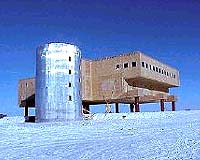| . |  |
. |
Bremerhaven Germany (SPX) May 10, 2010 Currently the yearly General Assembly of the European Geological Union takes place in Vienna, Austria. Dr. Olaf Eisen from the German Alfred Wegener Institute presents results from an environmentally friendly measurement method that he and his colleagues used on an Antarctic ice-shelf for the first time in early 2010. It supplies data that are input to models for the ice mass balance and thus permit better forecasting of future changes in the sea level. The quality of scientific models depends to a decisive degree on the available database. Therefore members of a young investigators group supported by the German Research Foundation (DFG) now applied a special geophysical measurement method, vibroseismics, for data collection in the Antarctic for the first time. "By means of vibroseismic measurements, we would like to find out more about the structure of the ice and thus about the flow characteristics of the Antarctic ice sheet," explains Dr. Olaf Eisen from the Alfred Wegener Institute for Polar and Marine Research in the Helmholtz Association. He is head of the LIMPICS young investigators group (Linking micro-physical properties to macro features in ice sheets with geophysical techniques). Eisen now presents first results from geophysical measurement campaign in the Antarctic on the international conference. The objective of the expedition was to determine the internal structure of an ice sheet from its surface by means of geophysical methods. The cooperation partners are the Universities of Bergen (Norway), Swansea (Wales, UK), Innsbruck (Austria) and Heidelberg (Germany) and the Commission for Glaciology of the Bavarian Academy of Sciences and Humanities. For test purposes vibroseismics was used along with proven explosive seismic methods for the first time on an ice sheet. One of the problems involved in the application of seismic methods on ice sheets is the very porous firn layer, which may be 50 to 100 metres thick. Explosive seismics involves drilling a hole, approximately 10 to 20 metres deep, into the firn to achieve a better coupling between the explosive charge and the surrounding firn or ice. Drilling takes a lot of time and permits only slow progress along the seismic profiles. Vibroseismics entails the generation of seismic waves directly on the surface. For this purpose the vibrator pad of a 16-ton vibroseis truck of the University of Bergen is pressed onto the precompressed firn and set into operation at a defined vibration rate. In contrast to explosive seismic methods, the excited seismic signal is known and can be repeatedly generated as frequently as desired, leading in the end to improved data quality. However, the loss of seismic energy in the porous firn is a disadvantage. Therefore, the scientists compare the explosive seismic and vibroseismic methods quantitatively and in this way want determine how much energy is propagating from the surface through the ice and reflected back to the surface. First data analyses show that vibroseismics is coequal to the classic explosive seismics concerning the amplitude of the waves sent into deeper snow and ice layers. An explicit advantage is the lower effort and thus less time and energy the scientists spend to measure seismic profiles now. Yngve Kristoffersen, professor of geophysics at the University of Bergen, who provides the vibroseismic equipment, explains: "The successful pilot study opens up a new era for efficient and more environmentally friendly methods for obtaining seismic information on the internal structure of the ice and the bedrock underneath it. This would extend our knowledge about how the ice sheet moves across the bedrock and about the geological structure of the rock under the ice." Furthermore, in the coming years this method will be applied during pre-site surveys of future geological drill sites under ice shelves, which will contribute to a better understanding of climate history.
Share This Article With Planet Earth
Related Links European Geological Union Beyond the Ice Age
 Antarctic Broadband Satellite Project Team Celebrates Grant
Antarctic Broadband Satellite Project Team Celebrates GrantCanberra, Australia (SPX) Mar 16, 2010 The team behind a project to deliver broadband satellite communications to Antarctica is celebrating after being awarded a $2.11 million grant under Round 1 of the Australian Space Research Program. The project is being led by Aerospace Research Pty Ltd the research arm of Aerospace Concepts Pty Ltd, an Australian aerospace and systems engineering house with extensive experience in space r ... read more |
|
| The content herein, unless otherwise known to be public domain, are Copyright 1995-2010 - SpaceDaily. AFP and UPI Wire Stories are copyright Agence France-Presse and United Press International. ESA Portal Reports are copyright European Space Agency. All NASA sourced material is public domain. Additional copyrights may apply in whole or part to other bona fide parties. Advertising does not imply endorsement,agreement or approval of any opinions, statements or information provided by SpaceDaily on any Web page published or hosted by SpaceDaily. Privacy Statement |